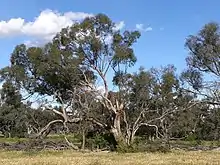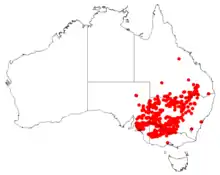Eucalyptus largiflorens
Eucalyptus largiflorens, or black box,[2] is a tree that is endemic to Australia. It has rough, fibrous or flaky bark, dull greenish-grey, lance-shaped leaves, oval to club-shaped green to yellow flower buds, white flowers and hemispherical, cup-shaped or barrel-shaped fruit.
| Black box | |
|---|---|
.jpg.webp) | |
 | |
| Scientific classification | |
| Kingdom: | Plantae |
| Clade: | Tracheophytes |
| Clade: | Angiosperms |
| Clade: | Eudicots |
| Clade: | Rosids |
| Order: | Myrtales |
| Family: | Myrtaceae |
| Genus: | Eucalyptus |
| Species: | E. largiflorens |
| Binomial name | |
| Eucalyptus largiflorens | |
 | |
| Occurrence data from AVH | |
| Synonyms[1] | |
| |
Description
Eucalyptus largiflorens is a tree that grows to a height of 20 metres (66 ft) with rough bark to the thinnest branches. The bark is dark grey and fibrous or flaky, sometimes furrowed on the trunk. The leaves on young trees are dull greyish green to bluish, linear to narrow lance-shaped, 40–155 mm (2–6 in) long and 4–18 mm (0.2–0.7 in) wide. Adult leaves are lance-shaped, the same shade of green on both sides, 60–180 mm (2–7 in) long and 8–20 mm (0.3–0.8 in) wide. The flowers are arranged in groups of mostly between seven and eleven on the ends of the branches or in leaf axils on a cylindrical peduncle 3–11 mm (0.12–0.43 in) long, individual flowers on a cylindrical pedicel 1–5 mm (0.039–0.20 in) long. The mature buds are green to yellow, oval to club-shaped, 4–5 mm (0.16–0.20 in) long and 2–3 mm (0.079–0.12 in) wide. The operculum is hemispherical to cone-shaped, shorter and narrower than the flower cup. The stamens are white. Flowering occurs in most months but especially in autumn and spring. The fruit is a hemispherical to oval capsule, 3–6 mm (0.1–0.2 in) long and 3–5 mm (0.1–0.2 in) wide.[2][3][4][5][6]
Taxonomy
Eucalyptus largiflorens was first formally described in 1855 by Ferdinand von Mueller and the description was published in Transactions and Prodeedings of the Victorian Institute for the Advancement of Science.[7][8] The specific epithet (largiflorens) is derived from the Latin words largus meaning "abundant"[9] and florens meaning "blooming",[10] referring to the size of the inflorescence.[4]
Distribution
The black box is widespread in Queensland, New South Wales, Victoria and South Australia, especially in grassy woodland on the floodplains of the Murray–Darling basin, but usually in dryer sites than river red gum (E. camaldulensis).
Use by Indigenous Australians
The small seeds of the black box were eaten raw by Indigenous Australians when grass seeds were scarce. Fruiting branches were cut down and placed in the sun to induce the capsules to open. Once the seeds were extracted, they were soaked and treated with several changes of water to remove the bitterness. They were then dried, ground on a grinding stone, and eaten raw.[11]
See also
References
- "Eucalyptus largiflorens". APNI. Retrieved 16 February 2019.
- Hill, Ken. "Eucalyptus largiflorens". Royal Botanic Garden Sydney. Retrieved 17 February 2019.
- Brooker, M. Ian; Slee, Andrew V. "Eucalyptus largiflorens". Royal Botanic Gardens Victoria. Retrieved 17 February 2019.
- "Eucalyptus largiflorens". Euclid: Centre for Australian national Biodiversity Research. Retrieved 1 June 2020.
- Chippendale, George McCartney. "Eucalyptus largiflorens". Australian Biological Resources Study, Department of the Environment and Energy, Canberra. Retrieved 17 February 2019.
- "Eucalyptus largiflorens". State Herbarium of South Australia. Retrieved 17 February 2019.
- "Eucalyptus largiflorens". APNI. Retrieved 17 February 2019.
- von Mueller, Ferdinand (1855). "Description of fifty new Australian plants, chiefly from the colony of Victoria". Transactions and Proceedings of the Victorian Institute for the Advancement of Science. 1: 34. Retrieved 17 February 2019.
- Brown, Roland Wilbur (1956). The Composition of Scientific Words. Washington, D.C.: Smithsonian Institution Press. p. 460.
- Lewis, Charlton T. "florens". An Elementary Latin Dictionary. Retrieved 17 February 2019.
- Cribb, J.W. & Cribb, A.B. (1975). Wild Food in Australia. Sydney: Fontana/Collins. ISBN 0-00-634436-4.CS1 maint: multiple names: authors list (link)